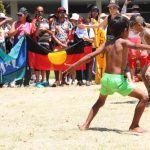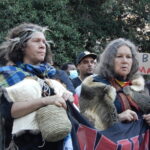Government Ignores Revered Report on Reducing First Nations Incarceration

The recent resurgence of the Stop Aboriginal Deaths in Custody movement has drawn renewed focus towards the overpolicing and overincarceration of First Nations people, as well as the systemic racism that’s leading to their overrepresentation in the criminal justice system.
The national custody figures for March this year reveal that 29 percent of the adult prisoner population in this country is made up of First Nations people, despite them only making up just under 3 percent of the overall populace.
While many have pointed to the 339 recommendations of the 1991 Royal Commission into Aboriginal Deaths in Custody as a way forward, others as well hold up the Australian Law Reform Commission’s (ALRC) 2018 report Pathways to Justice as a roadmap for change.
Curtin University senior research fellow Dr Hannah McGlade recently remarked to Sydney Criminal Lawyers that there’s a “need to see the implementation of the ALRC inquiry Pathways to Justice”, as there hasn’t been “a proper response to that”.
While a recent UNSW-led open letter on ending the overcriminalisation of First Nations peoples signed by over 300 criminologists and other academics called for the urgent application of the ALRC report recommendations.
So, we decided to take a look at this ground breaking report with a focus on criminal law and legal framework reforms as a means to address the disproportionate incarceration of Aboriginal and Torres Strait Islander peoples.
Just reinvest
Tabled on 28 March 2018, the Pathways to Justice report posits that in relation to the overincarceration of First Nations people, what’s needed is equality before the law. And it underscores that this means substantive equality, not mere formal equality.
Substantive equality before the law is based on the recognition of basic rights and entitlements, but it’s not a one-size-fits-all approach, as is formal equality. The substantive model recognises that what might be just for the non-Indigenous population can translate as repressive to First Nations people.
And to be able to achieve substantive equality, the authors recommend that localised justice approaches be taken to specific communities, which would be led and developed by local First Nations leaders.
The report recognises that localised approaches would be difficult for Australian governments to implement, as the traditional approach involves one homogenous justice system per jurisdiction. Although, in the long run, localised models would save money, as well as lives.
And in achieving this outcome, the ALRC recommends taking a justice reinvestment approach, which entails “the redirection of resources from the criminal justice system into local communities that have a high concentration of incarceration and contact with” police and the courts.
According to the report, justice reinvestment works as it’s well established that the key drivers of overincarceration are external to the justice system, and this method addresses those external factors to prevent criminalisation, with a place-based approach led by the community.
Reducing incarceration
The ALRC found that criminal justice overrepresentation increases at each stage of the system.
In 2016, First Nations people were seven times more likely to be charged than non-Indigenous people. They were 11 times more likely to be remanded and 12.5 times more likely to receive a sentence.
The Pathways to Justice report then goes on to consider key aspects of the criminal justice system that can be reformed to prevent this disproportionate representation of Aboriginal and Torres Strait Islander peoples from continuing.
Around a third of First Nations inmates are on remand, meaning they’ve been refused bail prior to their trial. The report recommends that jurisdictions develop guidelines for the provision of bail that allows authorities to consider a person’s Aboriginality when deciding whether they’re eligible.
A further bail issue is that those who are granted it often break conditions, such as curfews, due to cultural obligations that authorities don’t consider. The report suggests redrafting culturally appropriate bail conditions with the aid of Indigenous organisations.
In regard to sentencing, the ALRC maintains that courts should be required to take into account the “unique systemic and background factors” affecting Aboriginal people. And in the higher courts – district and supreme – these factors should be documented via a specific report.
Another key issue is that despite jurisdictions providing community-based sentencing options that divert people from prison, these are less likely to be applied to First Nations people. The report recommends broadening community-based options and again making them culturally appropriate.
Further considerations
The ALRC also points to improvements that need to be made to the parole system. It recommends that First Nations prisoners who are already eligible for parole be encouraged to apply for it, while culturally appropriate throughcare programs be available to provide guidance on release.
Of course, another key area that the report considers is policing. The ALRC recommends that police practices and procedures are reviewed – especially discretion – “so that the law is applied equally and without discrimination with respect to Aboriginal and Torres Strait Islander peoples”.
The commission also recommends an overhaul of the police complaints system so that First Nations people have confidence that their complaints are being taken seriously, and that police misconduct will be addressed.
Cast onto the pile
Despite the federal government commissioning the report and advocates lauding its approach, Pathways to Justice and its 35 recommendations on Indigenous overincarceration, have been ignored by the Coalition. Indeed, there has been no formal response.
Instead, what we’ve seen from the Morrison government is the implementation of new justice goals as part of the 2020 Closing the Gap scheme, which includes a target for reducing the adult First Nations prisoner population by 15 percent by 2031.
However, as NATSILS co-chair Cheryl Axleby made clear in July, the 15 percent inmate reduction goal isn’t acceptable, as change needs to come “in our lifetimes”, whereas this target wouldn’t bring about real parity in prisoner representation with the non-Indigenous population until 2093.
And one last point the ALRC thought it “important to bear in mind” is that “while the statistics concerning the disproportionate incarceration of Aboriginal and Torres Strait Islander peoples are alarming”, the majority of First Nations people “never commit a criminal offence”.







